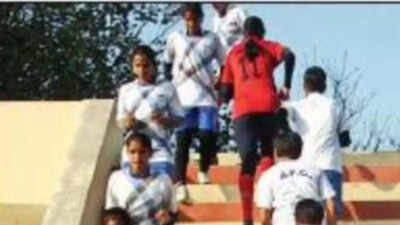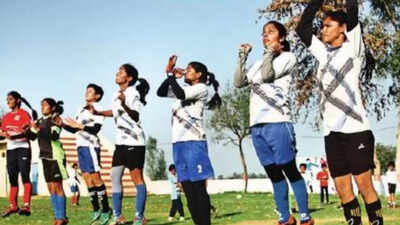- News
- The Times of a Better India News
- In this Haryana village, football is helping girls find their feet
In this Haryana village, football is helping girls find their feet
NEW DELHI: No energy drinks or supplements for them, not even a special diet. Cadets at Haryana’s top football nursery for girls drink water from a hand pump near the playground and munch on sprouted chana to keep their energy level high.
We are in Alakhpura, a village of 2,000 residents in Haryana’s Bhiwani district where young girls took to football in 2006, inspired not by the Fifa World Cup that year but the promise of scholarships to help their low-income families. Sixteen years on, football is part of the village life with more than 200 girl trainees practising twice a day – from 6am to 8am, and from 3pm to 6pm.
Daughters An Asset Here
In Alakhpura, daughters are not seen as a liability anymore. After all, 20 of those trained in the village football field have got government jobs in the Indian Railways, paramilitary forces such as Central Reserve Police Force (CRPF), Sashatra Seema Bal (SSB) and Assam Rifles, and even Haryana’s education department.
The jobs mean a lot because most of the girls are from families classified as ‘below the poverty line’ (BPL). They can’t afford to buy a domestic plane ticket but most have passports to represent the country in international events. Change arrived in Alakhpura when Gordhan Dass, a physical training instructor posted at the village’s government school, introduced football for girls in 2006. He prepared the ground for football with the help of Alakhpura residents, and motivated girls to play football.
Sonika Bijarnia, Alakhpura’s football coach for girls since 2014, says initially the only motivation for the girls was the Haryana government’s scholarship money for playing well in competitions (Alakhpura girls get around Rs 90 lakh every year from the state in scholarships). But when football became the key to government jobs, every household in the village began nudging girls to play football.
While the state government bore the cost of coaching and equipment, the village registered its Alakhpura Football Club (AFC) and started crowdfunding a part of the trainees’ expenses. Today, when an Alakhpura girl or the village team comes home a winner, the panchayat and the football club greet them with a victory procession.
Hunger For Victory
Despite their limited facilities and resources, Alakhpura girls have beaten teams from the Northeast, where football is a traditional sport. Their success comes down to an insatiable hunger for victory fuelled by thoughts of competing across the country, trying different cuisines at the venues, getting rewarded with new shoes and kits, and finally landing a government job.
That’s why, of the 20 players in Haryana’s women’s football team, about 10 are from Alakhpura. Two girls from the village – Ritu and Santosh – are in the national women’s football (senior) team and two others – Shelja and Varshika – are in the Under-17 World Cup camp. Altogether, 75 Alakhpura girls have participated in various national-level competitions in different age groups and 12 have played in international-level events. The seed that coach Gordhan Dass planted had started bearing fruit quickly. In 2011 and 2013, Alakhpura girls were runners-up in the prestigious Subroto Cup. In 2015 and 2016, they won the Cup. They also reached the semi-finals in the 2017 women’s football league.
Dass, who is now posted in a nearby village, says the Alakhpura experiment has proved that every village has such talent – all it needs is the right training. He feels happy seeing “the girls are getting jobs on their own and becoming financially independent. They are not seen as a burden or liability by the villagers. ”
In this Haryana village, football is helping girls find their feet
We are in Alakhpura, a village of 2,000 residents in Haryana’s Bhiwani district where young girls took to football in 2006, inspired not by the Fifa World Cup that year but the promise of scholarships to help their low-income families. Sixteen years on, football is part of the village life with more than 200 girl trainees practising twice a day – from 6am to 8am, and from 3pm to 6pm.
Daughters An Asset Here
In Alakhpura, daughters are not seen as a liability anymore. After all, 20 of those trained in the village football field have got government jobs in the Indian Railways, paramilitary forces such as Central Reserve Police Force (CRPF), Sashatra Seema Bal (SSB) and Assam Rifles, and even Haryana’s education department.
The jobs mean a lot because most of the girls are from families classified as ‘below the poverty line’ (BPL). They can’t afford to buy a domestic plane ticket but most have passports to represent the country in international events. Change arrived in Alakhpura when Gordhan Dass, a physical training instructor posted at the village’s government school, introduced football for girls in 2006. He prepared the ground for football with the help of Alakhpura residents, and motivated girls to play football.
Sonika Bijarnia, Alakhpura’s football coach for girls since 2014, says initially the only motivation for the girls was the Haryana government’s scholarship money for playing well in competitions (Alakhpura girls get around Rs 90 lakh every year from the state in scholarships). But when football became the key to government jobs, every household in the village began nudging girls to play football.
While the state government bore the cost of coaching and equipment, the village registered its Alakhpura Football Club (AFC) and started crowdfunding a part of the trainees’ expenses. Today, when an Alakhpura girl or the village team comes home a winner, the panchayat and the football club greet them with a victory procession.
Hunger For Victory
Despite their limited facilities and resources, Alakhpura girls have beaten teams from the Northeast, where football is a traditional sport. Their success comes down to an insatiable hunger for victory fuelled by thoughts of competing across the country, trying different cuisines at the venues, getting rewarded with new shoes and kits, and finally landing a government job.
That’s why, of the 20 players in Haryana’s women’s football team, about 10 are from Alakhpura. Two girls from the village – Ritu and Santosh – are in the national women’s football (senior) team and two others – Shelja and Varshika – are in the Under-17 World Cup camp. Altogether, 75 Alakhpura girls have participated in various national-level competitions in different age groups and 12 have played in international-level events. The seed that coach Gordhan Dass planted had started bearing fruit quickly. In 2011 and 2013, Alakhpura girls were runners-up in the prestigious Subroto Cup. In 2015 and 2016, they won the Cup. They also reached the semi-finals in the 2017 women’s football league.
Dass, who is now posted in a nearby village, says the Alakhpura experiment has proved that every village has such talent – all it needs is the right training. He feels happy seeing “the girls are getting jobs on their own and becoming financially independent. They are not seen as a burden or liability by the villagers. ”
In this Haryana village, football is helping girls find their feet
FOLLOW US ON SOCIAL MEDIA
FacebookTwitterInstagramKOO APPYOUTUBE
Start a Conversation
end of article


